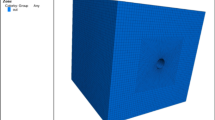Abstract
Elastic parameters such as Young’s modulus and Poisson’s ratio are significant to demarcate the damage zone around circular opening of tunnels. In the present study, a three dimensional finite difference numerical code, FLAC3D has been employed to study the effect of elastic parameters (E and v) on the radial displacement along the longitudinal direction around circular tunnel in hydrostatic field conditions. The tunnel is assumed to be driven in a homogeneous, isotropic, linear elastic rock mass. The results are compared with work done by previous researchers. Also, volumetric strain around tunnel and its behavior near the tunnel face have also been investigated to examine the failure behavior near the tunnel face. The material properties incorporated in the numerical model were taken in the range of common Indian rocks strength properties where most of the tunneling activities are going on. The empirical equation based on influence of Young’s modulus and Poisson’s ratio on radial deformation along the longitudinal axis of tunnel has been provided. Also, the relations between elastic parameters (E and v) and radial displacement has been proposed for future use in similar rock conditions.
Access this chapter
Tax calculation will be finalised at checkout
Purchases are for personal use only
Similar content being viewed by others
References
Abel JF, Lee FT (1973) Stress changes ahead of an advancing tunnel. Int J Rock Mech Min Sci Geomech Abstr 10:673–679
Bieniawski ZT (1978) Determining rock mass deformability: experience from case histories. Int J Rock Mech Min Sci Geomech Abstr 15:237–247
Brady BHG, Brown ET (1985) Rock mechanics for underground mining. Allen & Unwin, London
Carranza-Torres C, Fairhurst C (2000) Application of the convergence confinement method of tunnel design to rock masses that satisfy the Hoek–Brown failure criterion. Tunn Undergr Space Technol 15(2):187–213
Corbetta F, Bernaud D, Nguyen-Minh D (1991) Contribution a la ` method convergerce–confinement par le principe de la similitude. Rev Fr Geotech 54:5–11
Guilloux A, Bretelle S, Bienvenue F (1996) Prise en compte des pre-soutenements dans le dimensionnement des tunnels. Rev Fr Geotech 76:3–16
Hoek E, Brown ET (1980) Underground excavations in rock. Institute of Mining and Metallurgy, London, pp 84–96
Itasca (1997) FLAC3D fast Lagrangian analysis of continua in 3 dimensions V.2.0. Itasca Consulting Group, Inc., Minnepolis
Jaeger JC, Cook NGW (1976) Fundamentals of rock mechanics, 2nd edn. Chapman & Hall, London
Niwa Y, Kobayashi S, Fukui T (1979) Stresses and displacements around an advancing face of a tunnel. In: Proceedings of the 4th international congress on rock mechanics, vol 1, ISRM. Balkema, Rotterdam, pp 703–710
Obert L, Duvall WI (1967) Rock mechanics and the design of structures in rock. Wiley, New York, 650 p
Panet M (1993) Understanding deformations in tunnels. In: Hudson JA, Brown ET, Fairhurst C, Hoek E (eds) Comprehensive rock engineering, vol 1. Pergamon Press, Oxford, pp 663–690
Panet M (1995) Calcul desT unnels par la Methode de Convergence–Confinement. Presses de l’Ecole Nationale des Ponts et Chaussees, Paris, p 178
Panet M, Guenot A (1982) Analysis of convergence behind the face of a tunnel. In: Proceedings of the international symposium on tunnelling, London, pp 197–204
Pellet F, Verma AK (2006) The effect of excavation rate on tunnel stability. Technical session 3H, A168. In: Second international congress on computational mechanics and simulation (ICCMS 06). IIT, Guwahati
Pelli F, Kaiser PK, Morgenstern NR (1991) The influence of near face behaviour on monitoring of deep tunnels. Can Geotech J 28:226–238
Sakurai S (1978) Approximate time-dependent analysis of tunnel support structure considering progress of tunnel face. Int J Numer Anal Methods Geomech 2:159–175
Serafim JL, Pereira JP (1983) Consideration of the geomechanics classification of Bieniawski. In: Proceedings of international symposium on engineering geology and underground constructions, Lisbon, pp 1133–1144
Singh TN, Verma AK (2007) Evaluating the slope instability of the Amiya slide. In: Eberhardt E, Stead D, Morrison T (eds) Rock mechanics. Meeting society challenges and demand. Taylor & Francis, London, pp 993–998
Singh TN, Verma AK (2009) Stress response around fracture surface under uniaxial loading. e-Journal Earth Sci India 2(3):148–159
Sitharam TG, Maji VB, Verma AK (2005) Equivalent continuum analyses of jointed rockmass. In: 40th U.S. symposium on rock mechanics (USRMS): rock mechanics for energy, mineral and infrastructure development in the northern regions, Alaska, pp 25–29
Sulem J, Panet M, Guenot A (1987) An analytical solution for time dependent displacements in a circular tunnel. Int J Rock Mech Min Geomech Abstr 24(3):155–164
Unlu T, Gercek H (2003) Effect of Poisson’s ratio on the normalized radial displacement occurring around the face of a circular tunnel. Tunn Undergr Sp Technol 18:547–553
Verma AK, Singh TN (2010) Assessment of tunnel instability – a numerical approach. Int J Arab Geosci, Springer publication 3(2):181–192
Author information
Authors and Affiliations
Corresponding author
Editor information
Editors and Affiliations
Rights and permissions
Copyright information
© 2013 Springer-Verlag Berlin Heidelberg
About this chapter
Cite this chapter
Verma, A.K., Singh, T.N. (2013). Influence of Young’s Modulus and Poisson’s Ratio on the Displacement Around a Circular Tunnel. In: Sinha, R., Ravindra, R. (eds) Earth System Processes and Disaster Management. Society of Earth Scientists Series. Springer, Berlin, Heidelberg. https://doi.org/10.1007/978-3-642-28845-6_13
Download citation
DOI: https://doi.org/10.1007/978-3-642-28845-6_13
Published:
Publisher Name: Springer, Berlin, Heidelberg
Print ISBN: 978-3-642-28844-9
Online ISBN: 978-3-642-28845-6
eBook Packages: Earth and Environmental ScienceEarth and Environmental Science (R0)




